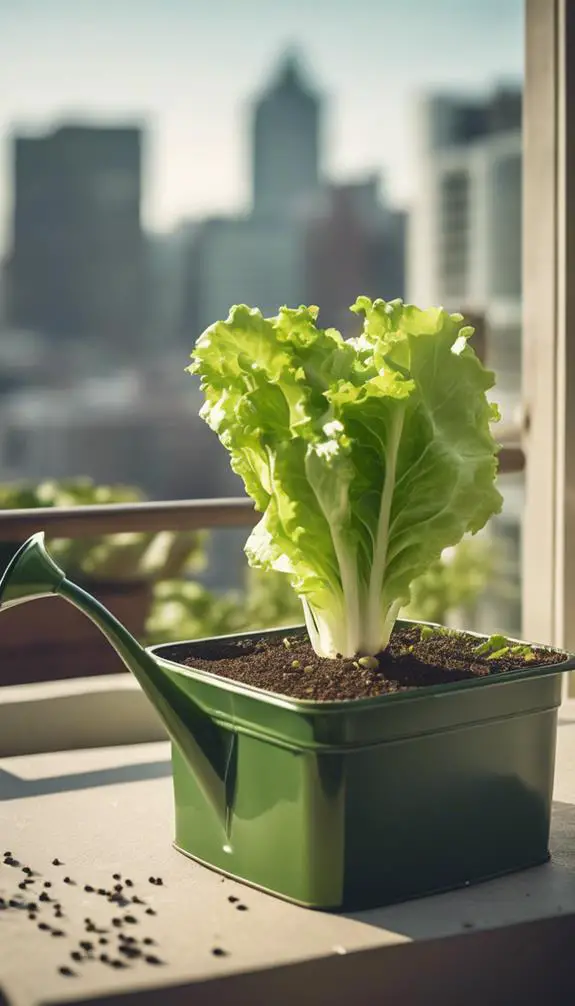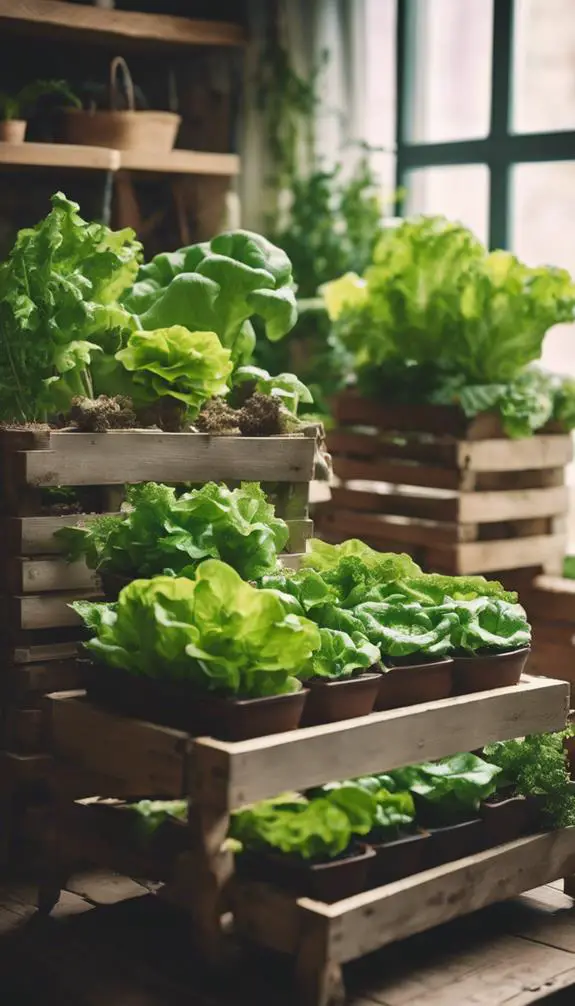You're interested in growing lily of the valley flowers, those delicate, bell-shaped blooms that exude a sweet, intoxicating fragrance. To get started, you'll need to create the perfect environment for them to thrive. That means preparing the soil, choosing the right light exposure, and providing the ideal amount of water and humidity. But that's just the beginning. With the right care and attention, your lily of the valley plants can become a stunning addition to your garden or indoor arrangements. But what are the specific steps you can take to guarantee their success?
Summary
- Plant lily of the valley in well-draining soil with a pH between 5.5 and 7.0, and add organic matter like compost or peat moss.
- Provide partial shade to full shade, depending on the climate, and ensure good air circulation to prevent fungal diseases.
- Water consistently, keeping the top 2-3 inches of soil moist, but avoid overwatering, which can lead to root rot.
- Fertilize with a balanced fertilizer (10-10-10 ratio) and test the soil regularly to identify any nutrient imbalances.
- Prune and train lily of the valley plants regularly to maintain shape, promote healthy growth, and encourage blooming.
Choosing the Right Soil Conditions

Ideal soil conditions lay the foundation for thriving lily of the valley flowers.
You'll want to create an environment that mimics their natural habitat, with a slightly acidic to neutral soil pH, ranging from 6.0 to 7.0.
To achieve this, you may need to add soil amendments such as peat moss or compost to lower the pH.
Additionally, guarantee good drainage by incorporating organic matter like perlite or vermiculite.
Avoid over-tilling, as this can damage the soil structure and disrupt the delicate balance of microorganisms.
Planting Lily of the Valley
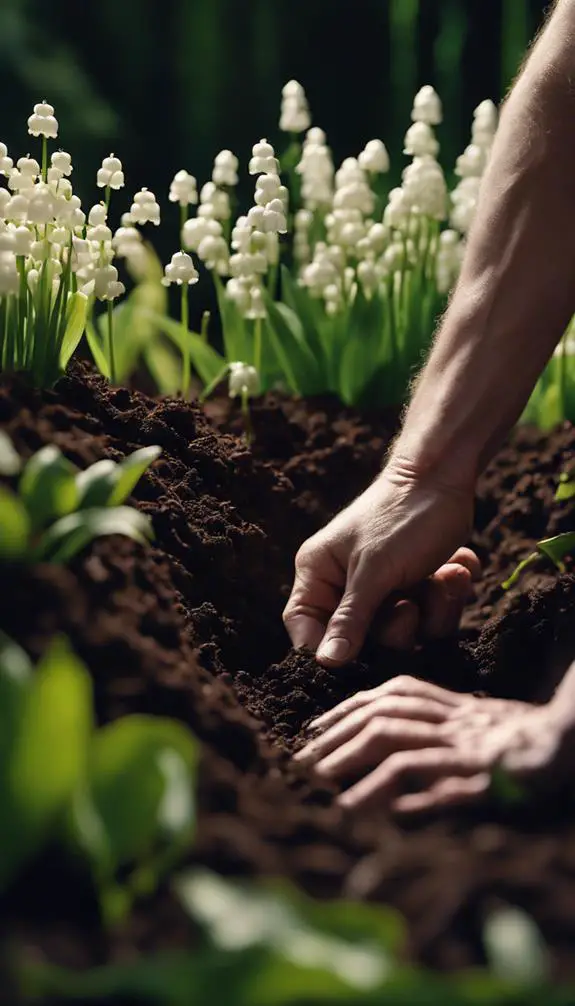
You'll want to choose a spot with the right soil, as you've prepared, and select a location that receives partial shade to full shade, depending on your climate.
When selecting the perfect spot, consider the mature size of the lily of the valley plants and leave enough space for them to spread.
Before planting, prepare the site by loosening the soil to a depth of 12-18 inches and adding organic matter like compost or well-rotted manure.
Choosing the Right Soil
When planting lily of the valley, the soil's pH level is crucial, as it directly affects the plant's growth and health.
You'll want to opt for soil with a pH between 5.5 and 7.0, as lily of the valley flourishes in slightly acidic to neutral soil.
Regarding soil types, choosing a well-draining mix that's rich in organic matter is paramount.
You can opt for a peat-based or loam-based soil, as these retain moisture but drain excess water.
Avoid heavy clay or sandy soils, as they can lead to root rot or drought stress.
Selecting the Perfect Spot
In selecting a spot for your lily of the valley, consider the amount of sunlight the area receives, as this flowering plant thrives in partial shade to full shade.
Avoid areas with direct sunlight, as it can cause the leaves to become scorched. You'll also want to choose a location with good air circulation to prevent fungal diseases.
Consider the Valley microclimates in your yard, such as areas near trees or buildings that may create unique temperature and moisture conditions.
When selecting lily companions, choose plants that share similar growing conditions, such as ferns, hostas, or impatiens.
Preparing the Planting Site
How much preparation does your planting site need before introducing lily of the valley flowers?
Conduct a site assessment to evaluate the area's conditions. Check for any debris, rocks, or weeds that may hinder growth. Remove any obstacles and level the ground to guarantee even water distribution.
Next, perform a soil testing to determine the pH level and nutrient content. Lily of the valley prefers well-draining, slightly acidic soil with a pH between 6.0 and 7.0.
Based on the test results, amend the soil with organic matter like compost or manure to achieve the ideal conditions. This preparation will give your lily of the valley flowers a strong foundation to thrive.
Providing Optimal Light Exposure

Most lily of the valley plants require partial shade to thrive, especially in warmer climates where direct sunlight can scorch the delicate leaves.
You'll want to provide your plants with morning sun and afternoon shade to achieve ideal light exposure. East- or west-facing windows or locations under a tree canopy are ideal.
Avoid direct sunlight, especially during the hottest part of the day, as it can cause leaf scorch and reduce flowering. If you're growing lily of the valley in a sunny location, consider using a sheer curtain or shade cloth to filter the sunlight.
Watering and Humidity Needs

Two to three inches of weekly moisture is essential for lily of the valley plants to thrive, as they prefer consistently moist soil without being waterlogged.
You can achieve this by checking the soil moisture levels regularly, ensuring the top 2-3 inches of soil feel moist to the touch.
Avoid overwatering, which can lead to root rot and other issues.
If you're unsure, check the water table by inserting your finger into the soil up to the knuckle.
If the soil feels dry, it's time to water.
Lily of the valley plants also prefer high humidity, typically above 50%.
You can increase humidity around your plants by placing the pot on a tray filled with water and pebbles or using a humidifier.
Fertilizing for Healthy Growth

When fertilizing your lily of the valley flowers, you'll want to maintain a balanced soil nutrient profile to promote healthy growth.
To achieve this, you'll need to establish a proper feeding schedule, taking into account the plant's nutritional needs during different stages of development.
Soil Nutrient Balance
Beyond the soil's pH level, achieving a delicate balance of nutrients is crucial for growing healthy lily of the valley flowers.
You'll want to guarantee your soil has the right mix of macronutrients like nitrogen, phosphorus, and potassium, as well as micronutrients like iron and zinc.
Nutrient deficiencies can lead to stunted growth, yellowing leaves, and reduced flowering.
Test your soil regularly to identify any imbalances and adjust your fertilizer application accordingly.
Aim for a balanced fertilizer with a ratio of 10-10-10 (nitrogen-phosphorus-potassium) to promote healthy growth.
Be cautious not to overfertilize, as this can damage your plants.
Proper Feeding Schedule
How frequently should you fertilize your lily of the valley flowers to promote healthy growth? The ideal fertilizer timing is vital.
You should fertilize your lily of the valley flowers during the growing season, which typically starts in early spring and ends in late summer.
During this period, you'll want to maintain a regular feeding frequency of every 4-6 weeks. This schedule allows your flowers to absorb the necessary nutrients for peak growth and blooming.
Be cautious not to overfertilize, as this can lead to weakened roots and reduced flowering. By sticking to this fertilizer timing and feeding frequency, you'll be well on your way to growing lily of the valley flowers that thrive.
Organic Fertilizer Options
You've established a regular feeding frequency to promote healthy growth in your lily of the valley flowers.
Now, it's time to explore organic fertilizer options that will further enhance their development. Consider using natural blends specifically formulated for flowering plants, which typically contain a balanced mix of nitrogen, phosphorus, and potassium.
Another innovative approach is compost tea, a liquid solution made by steeping compost in water. This nutrient-rich brew provides beneficial microbes that stimulate soil biota, leading to stronger, more resilient plants.
When selecting an organic fertilizer, look for certifications like OMRI or USDA Organic to guarantee the product meets rigorous environmental and health standards.
Pruning and Training Techniques

Regularly, lily of the valley plants require pruning and training to maintain their shape, promote healthy growth, and encourage blooming.
You'll need to cut back stems to about 6 inches from the ground after they've finished blooming. This encourages new growth and prevents the plant from becoming leggy.
When shaping arches, gently bend the stems to create a natural, curved shape. Secure them with twine or wire if necessary.
Prune any weak or damaged stems to promote air circulation and prevent disease.
Controlling Pests and Diseases
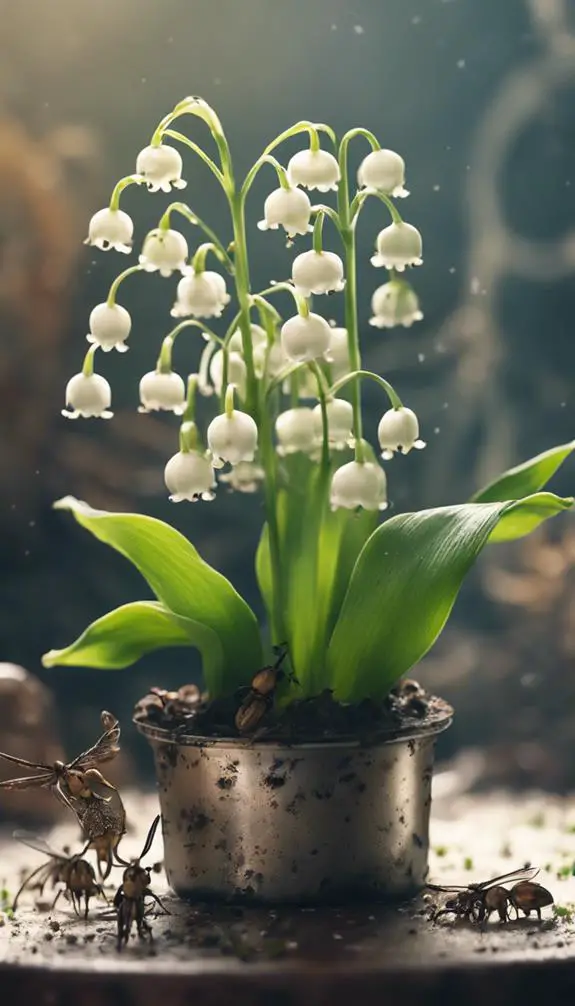
One of the most critical aspects of growing lily of the valley flowers is controlling pests and diseases, which can quickly devastate your plants if left unchecked.
You must regularly inspect your plants for signs of infestation or infection, practicing effective pest monitoring to catch any issues early.
Lily of the valley has some natural disease resistance, but crucially, you need to maintain good garden hygiene and remove any infected plants to prevent the spread of disease.
Preventative measures like providing good air circulation, watering carefully, and mulching around the base of your plants can also help reduce the risk of disease.
Propagating Lily of the Valley

By dividing established clumps or replanting the berries that form on the stems, you can easily propagate lily of the valley.
When dividing, dig up the entire clump, gently separating the stems and roots. Replant the fresh divisions in well-draining soil, making sure each section has at least one growing point. Water thoroughly and keep the soil consistently moist.
Alternatively, you can take root cuttings from mature plants in the fall or early spring. Cut sections of root about 2-3 inches long, remove any leaves, and plant them in a pot or directly in the ground. Keep the soil moist and warm until new growth appears.
With proper care, your new lily of the valley plants will thrive.
Transplanting Established Plants

When relocating established lily of the valley plants, timing is crucial.
You'll want to transplant them in the early spring or fall, when the plant is dormant. This reduces stress on the plant and allows it to establish itself quickly in its new location.
Dig up the entire established clump, taking care not to damage the roots. Gently separate the roots and replant the divisions 12-18 inches apart in well-draining soil.
Water thoroughly after transplanting and keep the soil consistently moist during the first growing season. Proper transplant timing and care will help your lily of the valley plants thrive in their new home.
Creating a Lily of the Valley Border
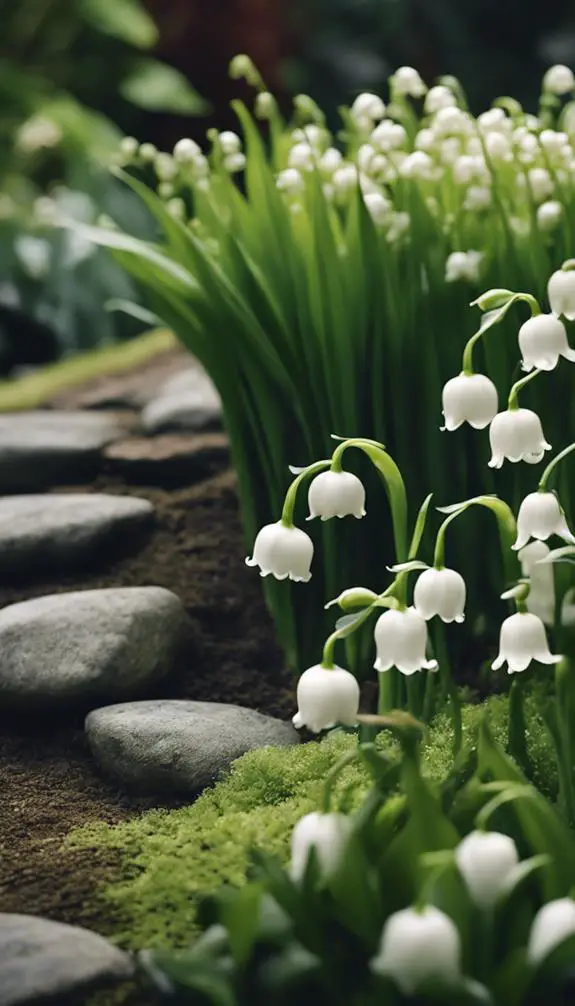
You'll want to ponder border design essentials, such as selecting a location with partial shade and well-draining soil, when creating a lily of the valley border.
This will guarantee your plants thrive and spread quickly.
Border Design Essentials
Frequently, a well-designed border serves as the backbone of a beautiful garden, and a lily of the valley border is no exception.
When creating your border, consider the style that will best showcase your lily of the valley flowers. Formal borders with clean lines and defined edges provide a sophisticated backdrop, while informal, curved borders create a whimsical atmosphere.
Edge definition is vital to maintain a polished look; use materials like metal, stone, or wood to create a clear boundary.
You can also incorporate other plants with similar growing conditions to add texture and visual interest. By selecting a border style that complements your lily of the valley, you'll create a stunning display that draws the eye.
Planting Lily of the Valley
To create a lily of the valley border, start by preparing the soil in the designated area, taking into account the mature size of the plants and the style of border you've chosen.
Dig to a depth of about 12 inches, loosening the soil to improve drainage. Add organic matter like compost or well-rotted manure to enrich the soil, as lily of the valley prefers rich, humus-rich soil.
Research the plant's history, rooted in Valley myths, to appreciate its beauty and significance.
Space individual plants about 12-18 inches apart, depending on the variety. Water thoroughly after planting and mulch around the plants to retain moisture.
Using Lily of the Valley in Arrangements

Three to five stems of lily of the valley flowers can add a delicate, whimsical touch to any arrangement.
You can use them to create a stunning flower crown by weaving the stems together with some greenery like eucalyptus or ferns.
For a more subtle look, incorporate lily of the valley into a fragrant posy, combining it with other sweet-smelling flowers like roses or freesias.
When working with lily of the valley, keep in mind that the stems are quite delicate, so handle them gently to avoid breakage.
You can also use them in smaller arrangements, like a petite vase or teacup, to add a touch of elegance to your table setting.
Caring for Potted Lily of the Valley

About a dozen potted lily of the valley plants thrive under consistent moisture levels, so water them when the top inch of soil feels dry to the touch.
Avoid overwatering, as this can lead to root rot. When selecting a pot, consider the mature size of the plant, leaving about 1-2 inches of space between the soil surface and the pot's rim.
This allows for proper air circulation and prevents waterlogged soil. Repotting frequency depends on the plant's growth rate, but as a general rule, repot every 2-3 years in the spring when the plant becomes pot-bound.
Choose a pot that's only 1-2 sizes larger to prevent the soil from becoming too wet.
Common Mistakes to Avoid
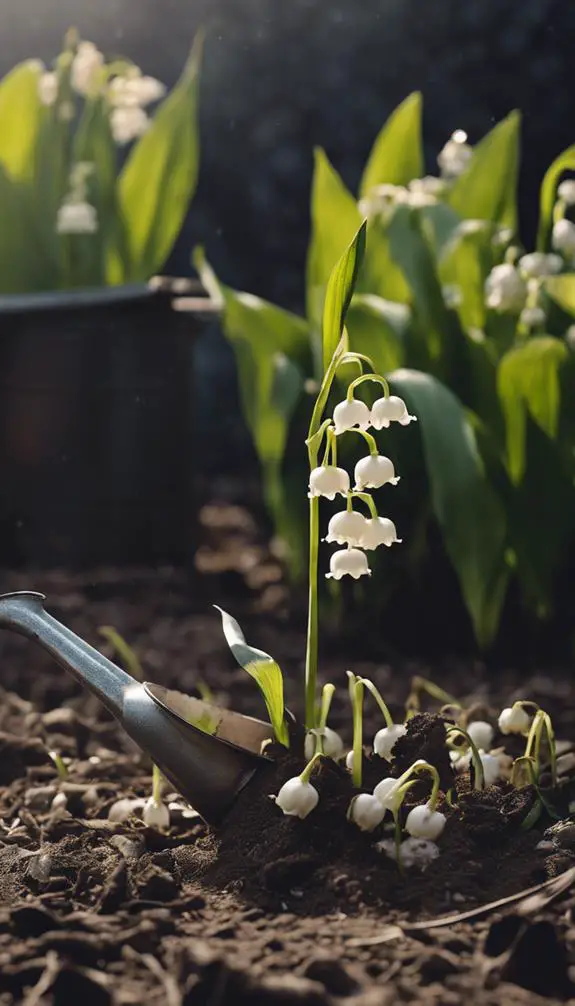
When cultivating lily of the valley, being aware of common mistakes can be the difference between a thriving plant and a struggling one.
You might mistakenly believe that all lily varieties are created equal, but some are more finicky than others. Don't fall for Valley myths that claim lily of the valley can thrive in full sun – it prefers partial shade.
Overwatering is another common mistake, as lily of the valley is prone to root rot. Make sure the soil drains well and avoid getting water on the leaves or crown.
FAQs
Can I Grow Lily of the Valley in a Container on My Patio?
You can grow lily of the valley in a container on your patio, provided it's partially shaded and has good drainage. This shade-tolerant beauty will thrive in a pot with rich soil, adding a touch of elegance to your patio decor.
Are Lily of the Valley Flowers Edible for Humans or Pets?
You should exercise extreme caution: lily of the valley flowers are toxic and pose significant food safety concerns for both humans and pets, as they contain cardiac glycosides that can cause severe illness or even death if ingested.
How Do I Preserve Fresh Lily of the Valley Blooms for Arrangements?
You'll extend fresh lily of the valley blooms' flower longevity in arrangements by air-drying or desiccating them; for ideal results, you'll gently mist and refrigerate stems before arranging to preserve their delicate beauty.
Can I Use Lily of the Valley as a Wedding Bouquet Flower?
You can create stunning wedding decor inspiration by incorporating lily of the valley into your bouquet, adding vintage charm elements like lace and pearls to evoke a whimsical, romantic atmosphere that will leave your guests enchanted.
Are Lily of the Valley Plants Deer-Resistant or Attractive to Wildlife?
You'll be relieved to know that lily of the valley plants aren't a deer magnet, but rather a wildlife haven; they're moderately deer-resistant, although occasional browsing might occur, especially if other food sources are scarce.
Conclusion
By following these guidelines, you'll be well on your way to successfully growing lily of the valley flowers. Remember to monitor your plants' progress, adjust your care routine as needed, and take necessary precautions to avoid common mistakes. With proper care, your lily of the valley will thrive, providing you with a beautiful display of delicate white blooms and sweet fragrance.


